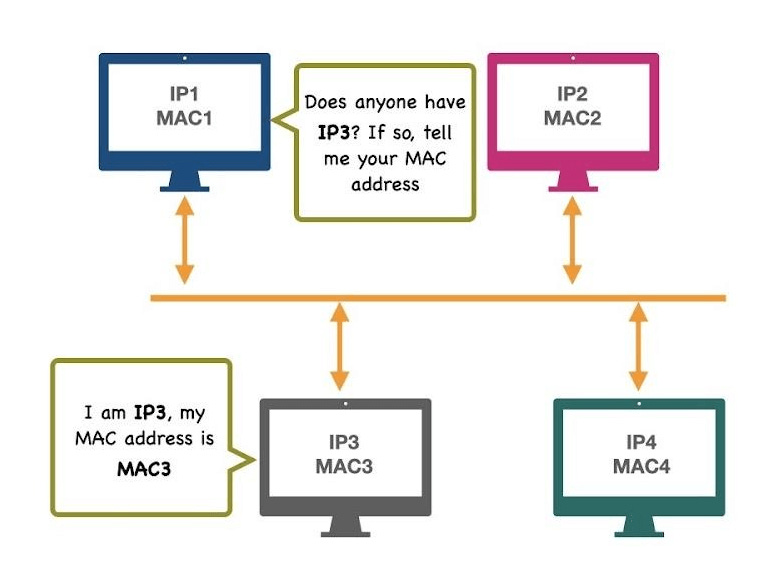How Does ARP Work
Pass Any Cisco Exam On Your First Try.
Want to boot your networking career ? This is the chance for you.
Address Resolution Protocol (ARP): An In-Depth Exploration
Introduction
The Address Resolution Protocol (ARP) is a fundamental protocol used within computer networks to map a known IP address to a corresponding MAC address. This process is essential for network communication in both local area networks (LANs) and larger networks. ARP enables devices to locate other devices on the same network segment, facilitating the direct delivery of packets.
The Basics of ARP
ARP operates at the Network layer of the OSI model, but it directly interacts with the Data Link layer. This dual-layer interaction is what makes ARP unique and critical for the seamless operation of network communications.
IP Addresses vs. MAC Addresses:
IP Addresses: These are logical addresses assigned to devices on a network. They are part of the Network layer and can change based on the network to which a device is connected.
MAC Addresses: These are physical addresses embedded in the network interface card (NIC) of a device. They operate at the Data Link layer and are unique to each NIC.
The main purpose of ARP is to translate the IP address into a MAC address, allowing packets to be correctly routed within a local network.
ARP Operation
The ARP process involves a few key steps:
ARP Request:
When a device wants to communicate with another device on the same network, it first checks its ARP cache (a table that stores mappings of IP addresses to MAC addresses).
If the desired IP address is not in the ARP cache, the device broadcasts an ARP request packet to all devices on the local network. This packet includes the sender’s IP and MAC addresses and the target IP address.
ARP Response:
The device with the matching IP address (the target) responds with an ARP reply. This reply is sent directly to the original sender and contains the target’s MAC address.
The original sender then updates its ARP cache with this new mapping.
Types of ARP
ARP has several variations, each serving a specific purpose:
Proxy ARP:
This occurs when one device (usually a router) answers ARP requests on behalf of another device. This is useful for enabling communication between devices on different subnets.
Gratuitous ARP:
A device sends an ARP request for its own IP address. This is used to detect IP address conflicts and update other devices’ ARP caches.
Inverse ARP (InARP):
Used primarily in Frame Relay and ATM networks, InARP is the reverse of ARP. It maps a known Data Link layer address to a Network layer address.
Reverse ARP (RARP):
An older protocol, RARP allows a device to discover its own IP address given its MAC address. RARP has largely been replaced by DHCP (Dynamic Host Configuration Protocol).
ARP Cache and Cache Management
The ARP cache is a crucial component in the ARP process. It stores the mappings of IP addresses to MAC addresses to speed up the resolution process and reduce network traffic. However, maintaining the ARP cache involves careful management:
Cache Entries:
Entries in the ARP cache are not permanent; they have a time-to-live (TTL) value. After the TTL expires, the entry is removed, and a new ARP request will be necessary if the mapping is needed again.
Cache Updates:
When an ARP reply is received, the ARP cache is updated with the new mapping. Gratuitous ARP packets can also update cache entries, ensuring that devices have up-to-date information.
Cache Size:
The size of the ARP cache can vary depending on the device and its operating system. Proper cache management helps avoid issues like cache poisoning and ensures efficient network communication.
ARP Spoofing and Security Concerns
ARP, while essential, has several security vulnerabilities:
ARP Spoofing (ARP Poisoning):
Malicious actors can exploit the lack of authentication in ARP messages to send false ARP replies. By doing so, they can associate their MAC address with the IP address of another device (such as a gateway), intercepting or redirecting traffic. This can lead to man-in-the-middle attacks, data theft, and other malicious activities.
Mitigation Techniques:
Static ARP Entries: Critical devices can have static ARP entries configured to prevent spoofing. However, this is not scalable for large networks.
ARP Inspection: Technologies like Dynamic ARP Inspection (DAI) can help detect and block ARP spoofing attempts.
VPNs and Encryption: Securing communication channels can mitigate the impact of ARP spoofing by ensuring data confidentiality even if traffic is intercepted.
ARP in Modern Networks
As network technologies evolve, the role of ARP remains significant, albeit with adaptations and enhancements:
IPv6 and Neighbor Discovery Protocol (NDP):
In IPv6 networks, ARP is replaced by the Neighbor Discovery Protocol (NDP), which provides similar functionality but with enhanced features such as address autoconfiguration, discovery of network devices, and reachability information.
Software-Defined Networking (SDN):
In SDN environments, centralized controllers can manage ARP resolution and address mappings more efficiently, reducing the reliance on traditional ARP broadcasts and improving network performance.
Virtualization and Cloud Networks:
Virtualized environments often have additional layers of abstraction and complexity. ARP plays a role in ensuring seamless communication between virtual machines (VMs) and across virtual networks.
Practical Example of ARP in Action
Consider a simple network with two devices, A and B, and a router R. Device A wants to send data to Device B. Here's how ARP would facilitate this communication:
Device A’s ARP Request:
Device A checks its ARP cache for Device B’s MAC address. Finding no entry, it broadcasts an ARP request: "Who has IP 192.168.1.2? Tell 192.168.1.1".
Device B’s ARP Reply:
Device B receives the ARP request, recognizes its own IP address, and replies with its MAC address: "192.168.1.2 is at 00:14:22:01:23:45".
Device A Updates ARP Cache:
Device A receives the ARP reply, updates its cache with the mapping (192.168.1.2 -> 00:14:22:01:23:45), and proceeds to send the data directly to Device B using its MAC address.
Advanced ARP Concepts
VLANs and ARP:
In networks with VLANs (Virtual Local Area Networks), ARP traffic is contained within the same VLAN. Inter-VLAN communication requires routing, and ARP requests are handled by the router or Layer 3 switch.
Load Balancers and ARP:
Load balancers often use ARP to maintain mappings for multiple backend servers, ensuring traffic is distributed efficiently across them.
ARP in Wireless Networks:
In wireless networks, ARP functions similarly to wired networks but must account for the additional dynamics of mobile devices and varying signal strengths.



